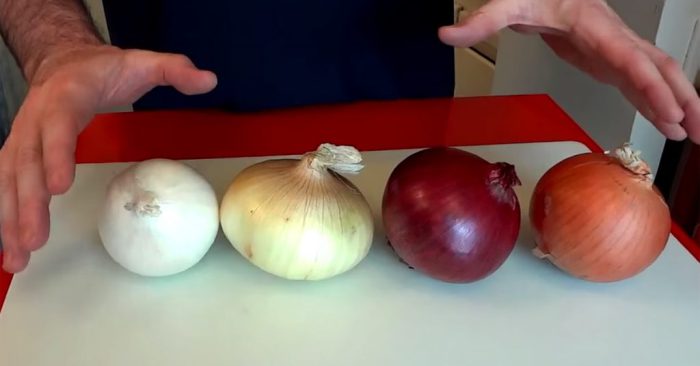With all the different types of onions out there, it’s hard to know what’s what! Picking out the wrong type of onion could be the difference between a masterpiece of a meal, and a complete nightmare.
Luckily, silly Chef Buck is here to guide us through the pros and cons of each onion, as well as how to cook them properly!
Yellow Onion
Pros: Low cost and available all year round.
Cons: None
Cooking Uses: These onions are great for just about anything. From soups to salad, and everything in between – yellow onions taste great! However, these are the type of onions you’ll want to use for carmeling since they’re high in sugar.
Red Onion
Pros: Strong spicy taste if eaten raw.
Cons: Not great for caramelizing or long cooking times.
Cooking Uses: These are wonderful for topping salads and grilling! Red onions also taste fantastic on burgers and sandwiches – anytime you can eat onions raw, this is the type to do it with!
Sweet Onion
Pros: Mild taste when consumed raw and goes great with many types of recipes.
Cons: Shorter shelf life.
Cooking Uses: Great for a variety of recipes (especially when used in slow cookers). The sweet taste is delicious raw or cooked and pairs well with items like tomatoes and potatoes!
White Onion
Pros: Sharp flavor and very versatile when used in cooking.
Cons: Thin skin and powerful impact on eyes when chopping.
Cooking Uses: White onions are a staple in Latin cooking! Throw them in a salsa, guacamole, tacos, or whatever else your heart desires. The strong raw taste is best when offset by other more gentle flavors! They also work as a great pizza topping!
Bonus: Shallot
Pros: Mild taste and a hint of garlic.
Cons: Expensive!
Cooking Uses: Use as a side for fancier meals and feasts – or sliced thinly in Asian-style cuisine! They are also great as a side dish for a Christmas Eve pot roast, or can work well when paired with a Thanksgiving turkey!
Enregistrer


